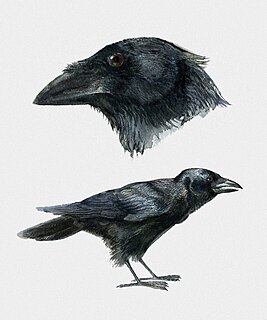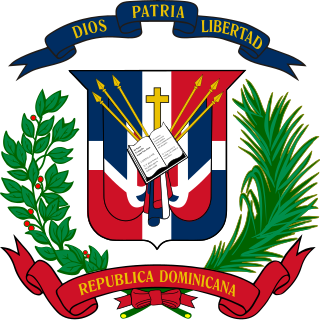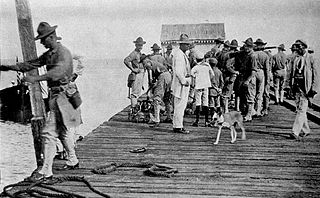
The Dominican Republic is a country located on the island of Hispaniola in the Greater Antilles archipelago of the Caribbean region. It occupies the eastern five-eighths of the island, which it shares with Haiti, making Hispaniola one of only two Caribbean islands, along with Saint Martin, that are shared by two sovereign states. The Dominican Republic is the second-largest nation in the Antilles by area at 48,671 square kilometers (18,792 sq mi), and third by population with approximately 10.5 million people, of whom approximately 3.3 million live in the metropolitan area of Santo Domingo, the capital city. The official language of the country is Spanish.

Hispaniola is an island in the Caribbean archipelago known as the Greater Antilles. It is the most populous island in the West Indies and the region's second largest after Cuba.

Dominicans are people who are identified with the Dominican Republic. This connection may be residential, legal, historical or cultural. For most Dominicans, several of these connections exist and are collectively the source of their being Dominicans.

Étang Saumâtre is the largest lake in Haiti and the second largest lake in Hispaniola, after Lake Enriquillo. It is also known as Lake Azuéi ; its Taíno name was Yainagua.

The palm crow is a relatively small corvid that occurs mostly on the Caribbean island of Hispaniola. It was formerly quite frequent on Cuba but has become severely reduced in number. This subspecies is slightly smaller and is usually separated as a subspecies called Corvus palmarum minutus. Both subspecies are usually now given the respective common names of Hispaniolan palm crow and Cuban palm crow to distinguish them.

The Dominican Republic is a unitary state with elected officials at the national and local levels. On a national level, head of state, the President, is elected directly by the people. All members of a national legislature, The Congress of the Republic divided in two chambers. The Chamber of Deputies and the Senate. There are also elected offices at the local level. It is estimated that across the whole country, over four thousand offices are filled in every electoral cycle.

Punta Cana is a resort town within the Punta Cana-Bávaro-Veron-Macao municipal district, in the municipality of Higüey, in La Altagracia Province, the easternmost province of the Dominican Republic. The area has beaches and balnearios which face both the Caribbean Sea and the Atlantic Ocean, and it is a tourist destination. The weather is hot and humid, especially in late summer and autumn when the Northern Tropics receive their most direct sunlight.

The first United States occupation of the Dominican Republic lasted from 1916 to 1924. It was one of the many interventions in Latin America undertaken by the military forces of the United States in the 20th century. On the 13 May 1916, Rear Admiral William B. Caperton forced the Dominican Republic's Secretary of War Desiderio Arias, who had seized power from Juan Isidro Jimenes Pereyra, to leave Santo Domingo by threatening the city with naval bombardment.

The Hispaniolan solenodon, also known as the Haitian solenodon, or agouta, is a solenodon found only on Hispaniola, the island shared by Haiti and the Dominican Republic. It was first described by Brandt in 1833. A similar but smaller species, Marcano's solenodon, once lived on the island, but became extinct after European colonization.
Antihaitianismo, also called anti-Haitianism in some English sources, is prejudice or social discrimination against Haitians in the Dominican Republic.
The La Selle red-legged frog or Furcy robber frog is a species of frog in the family Eleutherodactylidae. It is endemic to southern Hispaniola and occurs in both Haiti and the Dominican Republic. Specifically, it occurs on the Massif de la Selle (Haiti) to the western Baoruco Mountain Range. Its natural habitat is upland mesic pine forest, where it is usually found under rocks and logs. It is threatened by habitat loss caused by logging and agriculture. It is known from protected areas, but habitat loss continues also within those areas.
Eleutherodactylus wetmorei is a species of frog in the family Eleutherodactylidae. It is endemic to Hispaniola and occurs in both the Dominican Republic and Haiti. Specifically, it occurs on the Tiburon Peninsula (Haiti) and east to the Massif de la Selle in the southwestern Dominican Republic, and on the Massif du Nord in north-central Haiti east to west-central Dominican Republic. Its natural habitat is mesic broadleaf forest. It is an arboreal species occurring bromeliads and other plants, and also in leaf axils of bananas plantations. Eggs are laid in bromeliads. It is threatened by habitat loss caused by logging and agriculture. It is known from several protected areas, but most of them are in need of better management.

The ashy-faced owl is a species of owl in the family Tytonidae. It is found on Hispaniola. Its natural habitats are subtropical or tropical dry shrubland, subtropical or tropical high-altitude shrubland, and heavily degraded former forest.

Monte Cristi National Park is a national park on the Caribbean Island of Hispaniola that extends from the borders of Haiti to Punta Rucia in the Dominican Republic and covers an area of 550 km². It contains coastal lagoons, beaches, mangrove swamps, a 237 m (777 ft) limestone mesa from which can be seen offshore keys and forested slopes of the mesa's northern side.

The Cuban crocodile is a small-medium species of crocodile found only in Cuba. Typical length is 2.1–2.3 m (6.9–7.5 ft) and typical weight 70–80 kg (150–180 lb). Large males can reach as much as 3.5 m (11 ft) in length and weigh more than 215 kg (474 lb). Despite its modest size, it is a highly aggressive animal, and potentially dangerous to humans.
The Brachypsectridae are a family of beetles commonly known as the Texas beetles. There is only one genus, Brachypsectra. The type species, Brachypsectra fulva, occurs in North America. There are three other species which occur in southern India, Singapore and northwestern Australia. Two other extant and fossil species have been described from the Dominican Republic.

Anochetus exstinctus is an extinct species of ant in the subfamily Ponerinae known from two possibly Miocene fossils found on Hispaniola. A. exstinctus is one of eight species in the ant genus Anochetus to have been described from fossils found in Dominican amber and is one of a number of Anochetus species found in the Greater Antillies.

Sicoderus bautistai is a species of weevil in the genus Sicoderus indigenous to the island of Hispaniola. It is closely related to the species S. ramosi, S. guanyangi, and S. turnbowi. Its appearance has been described as similar to that of "black, shiny ants".












